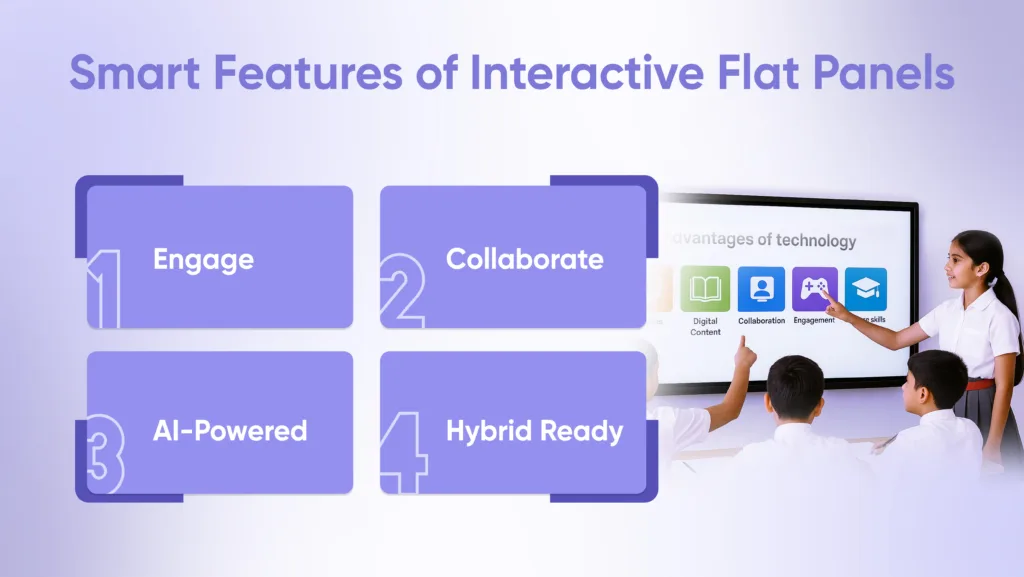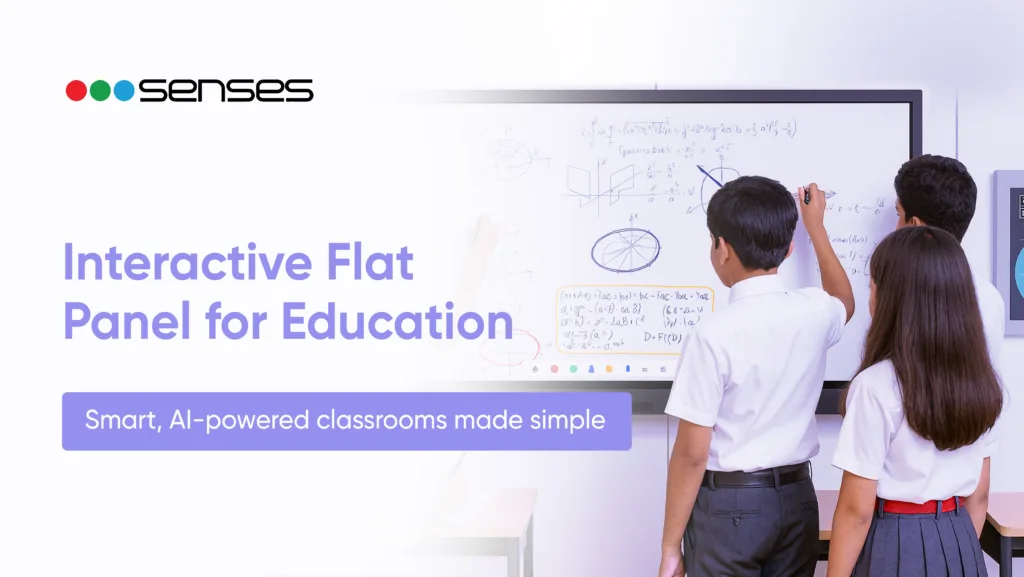Educational interactive flat panel displays are an updated educational technology that combines a large touchscreen display with advanced smart features, including artificial intelligence, handwriting, facial and gesture recognition, and data analytics.
An interactive flat panel is an enhancement over projectors and traditional whiteboards, offering clearer visuals, real-time collaboration, and the ability to create interactive learning experiences, all with anti-glare technology and seamless device connectivity. Interactive flat panels make classrooms more engaging, inclusive, and efficient.
This blog will explain the function of educational interactive flat panels, their advantages, features, and costs, and why educational institutions are embracing educational interactive flat panels as the ultimate educational technology digital classroom solution.
Key Takeaways:
- Interactive educational flat panels foster inclusive, cooperative, and engaging classrooms.
- AI features that enhance teaching & learning include data-driven insights, facial recognition, gesture, and handwriting.
- The flat panels also offer features such as video conferencing, recordings, and sharing of your content to support hybrid teaching.
- Time is saved for teachers, and students are engaged in interactive lessons with multimedia-rich content.
What is an Interactive Flat Panel?
An interactive flat panel display is a large digital screen with touch capabilities that serves as a big tablet for education settings. Teachers can write on it, students can write on it, and lessons can be presented in an interactive, multimedia-focused way.
- Interactive Flat Panel Display vs Other Tools
- Smartboard: Requires a projector, limited resolution.
- LED TV: Good for viewing; not interactive.
- Projector: Shallow clarity in bright rooms, very high maintenance.
- Interactive Flat Panel Display: 4K resolution, touch supported, multiple device connectivity, integrated operating systems.

Why Are Interactive Panels Important in Classrooms?
Interactive panels are changing both teaching and learning experiences by engaging students and making the lessons more interactive and collaborative.
1. Engagement via Multimedia
Each panel has anti-glare technology, so even in bright classroom lights, all students can see clearly. Using videos, animations, and interactive activities to engage students in their learning is seamless.
2. Collaboration and Group Work
Panels allow more than one student to write or draw at the same time, facilitating teamwork and group discussions and inspirational creativity- the possibilities are endless.
3. Real-Time Engagement Feedback
Instructors can assess student engagement using the interactive panels; quizzes can be conducted through the interactive, and immediate results can be made available.
4. Accessibility for All
Larger screens, with high-definition visuals and audio help make it possible for all students to learn, regardless of their learning needs.

AI Interactive Flat Panel: Smarter Learning with Technology
The newest AI interactive flat panel technologies expand beyond touch teaching—they think smart.
Teacher-Centric AI Capabilities
- Handwriting Recognition: Transcribes teacher notes and presents them as editable text.
- Gesture Recognition: Change screens, zoom in/out or open apps with a simple movement of the hand.
- Facial Recognition: Enables auto-login for teachers to facilitate class attendance for security, safety and accountability.
- Student Learning Analytics: With analytics based on data, schools can track student progress, track lesson engagement, and determine targets to address next.
Accessibility Features
AI-enabled speech-to-text and reading tools support differently abled students, resulting in a truly accessible digital classroom solution.
👉 Upgrading to Senses Electronics’ AI panels is smart automation for your classroom.
Classroom Uses of Interactive Flat Panels
An interactive flat panel for classrooms is more than just a screen it’s a complete digital classroom solution that changes how teachers start lessons and how students learn. Compared to traditional boards, flat panels make every subject easier to engage with, collaborate on, and learn.
Teachers become more efficient, students remain engaged, and schools can see real improvement in learning.
1. Math and Science Are Made Easy
Handwriting recognition, diagram-drawing capabilities, and touch technology make even the most complex equations and scientific diagrams disappear. Teachers can instantaneously plot graphs, real-time student interaction becomes possible, and technology enables science lab simulations in a virtual setting.
2. Language and Social Studies Become Engaging
Panels enhance reading lessons and geography activities with interactive maps and turn reading into an activity rather than a task.
Teachers can also incorporate gesture recognition technology in flat panels to zoom in on the maps, highlight text, or switch from slide to slide, keeping students active and engaged with a responsive environment.
3. Creativity in Arts & Coding
With an interactive flat panel display, art teachers can let multiple students draw together, while coding teachers can visually show their programming in step-by-step processes. Anti-glare technology provides clarity while students engage in creative learning sessions.
4. Hybrid & Remote Learning Made Easy
Teachers can virtually interact with students both inside and outside of the classroom thanks to integrated video conferencing features and content sharing choices! It is possible to record, save, and distribute lessons in order to build an everlasting digital library.
👉 Senses Electronics interactive flat panels are also equipped with AI, facial recognition, gesture recognition and handwriting identification, Therefore, making them perfect for any subject matter and any style of teaching.
Key Features to Look for in an Interactive Flat Panel Display
Picking the most appropriate interactive flat panel for the classroom relies upon identifying the necessary attributes.
1. Display Quality & Size
- 4K ultra-HD resolution is a moral must.
- Anti-glare technology for a better comfort level.
- Sizes available are 65″, 75″, and 86″, referenced to classroom size.
2. Touch & Writing Experience
- 20–40 touchpoints between the student and teacher for collaboration.
- Low latency and palm rejection assist with a successful writing experience.
- Handwriting recognition intelligence to convert notes into editable text.
3. Connectivity & Sharing
- Wireless screen sharing from laptops and mobiles.
- Multi-window support for large or smaller group activities.
- USB plug-in, HDMI plug and OPS slot for external devices.
Software & AI Tools
- Whiteboarding apps, typically within an infinite canvas.
- Lesson capture and export to cloud services.
- AI intelligence in gesture recognition and facial recognition, and data-driven insights.
4. Audio & Camera
- High-quality in-built speakers make it easier to hear the instructor.
- AI-enabled camera packages are optional and of value for hybrid teaching.

Interactive Panels vs Other Teaching Tools
Before investing, schools often compare flat panels with projectors, smartboards, or TVs.
| Feature | Interactive Flat Panel | Projector | Smartboard | LED TV |
| Resolution | 4K UHD | 720p–1080p | 1080p | 4K UHD |
| Touch | Yes | No | Limited | No |
| Maintenance | Low | High (bulbs, filters) | Medium | Low |
| Classroom Light | Works in bright light | Poor visibility | Moderate | Works |
| Collaboration | High | Low | Medium | Low |
How to Implement Interactive Panels in Schools
Implementing an educational interactive flat panel is far more complex than simply purchasing a screen; it is the development of a full solution to create a digital classroom that can transform teaching.
The key to a full implementation is an elegant plan to ensure teachers can use them effectively and the students will benefit from them.
Stage 1: Start with Trial Classrooms
First, the interactive flat panel for education should be installed in 2–3 classrooms. This will allow teachers and students to gradually learn about the features of the panel, such as handwriting recognition, gesture recognition, and the anti-glare feature, for 2–3 weeks prior to the panels being set up in the rest of the school.
Step 2: Teacher Development and Onboarding
Teachers determine when learners engage and commit to experiences in the classroom, and they are prepared to provide hands-on training. Teachers will learn to utilise features such as:
• Handwriting recognition that converts written notes into text
• Gesture recognition that allows shortcuts to navigate the user interface in no time at all
• Facial recognition that allows for secure login and class attendance
Benefit- a teacher’s assurance in using the panel will support lessons to progress smoothly, ensuring all students remain engaged.
Step 3: Integrate the Curriculum with the Content
The learning management system (LMS), which contains multimedia, videos, and eBooks, will be connected to the interactive flat panel display. The teacher will be able to build out lesson plans and integrate activities such as videos, PDFs, or interactive quizzes into the interactive flat panel display.
Step 4: Monitoring with Data-Driven Insights
The majority of modern panels have built-in analytics; you can likely obtain both data tracking and monitoring from any Senses Electronics panels. Schools will be able to report usage, analyse student engagement, and acquire analytics on areas of improvement.
Step 5: Expand to the Entire School
After successful implementation and buy-in from Teacher pilot classrooms, it is recommended that you expand your installation across all grades.
Adding additional tools, including AI Cameras, document cameras/scanners, and wireless or wireless microphone gamer setups that you will find from old Rugrats episodes from the organisers, will create a more integrated digital classroom solution.
Accessibility and Inclusion Benefits
An educational interactive flat panel ensures that no student is excluded.
Vision and Hearing Support
- Screen zoom and magnification.
- Audio routing to support hearing-impaired students.
Inclusive Teaching
- Support for UDL (Universal Design for Learning).
- Speech-to-text and text-to-speech services for a diverse group of learners.

Why Choose Senses Electronics Interactive Flat Panels?
Senses Electronics offers contemporary learning solutions for the digital classroom.
- 4K interactive flat panel displays with AI technology
- Functions such as handwriting recognition, gesture recognition, and facial recognition.
- Trusted after-sales support and nationwide service.
- Affordable pricing with excellent warranty coverage.
Conclusion
Digital learning is the future of education, and there is no greater force leading this change than the interactive flat panel for education. With attributes like AI tools, handwriting recognition, facial recognition, gesture recognition, anti-glare technology, and data-driven insights, interactive flat panels create a learning environment that is smarter, inclusive, and richer.
For schools and institutions that provide a world-class learning experience, an education interactive flat panel is not just a device – it is a requirement.
👉 Book your free demo today with Senses Electronics to see the future of education.
FAQs
The best size for classrooms varies: 65″ for small classrooms, 75″ for medium-sized classrooms, and 86″ or larger for larger classrooms.
Yes. Interactive panel by Senses supports the built-in cameras, microphones and cloud support.
Most panels can last 7-10 years with low maintenance.
AI features such as facial recognition, gesture recognition, and data insights enable smarter and more efficient teaching.

